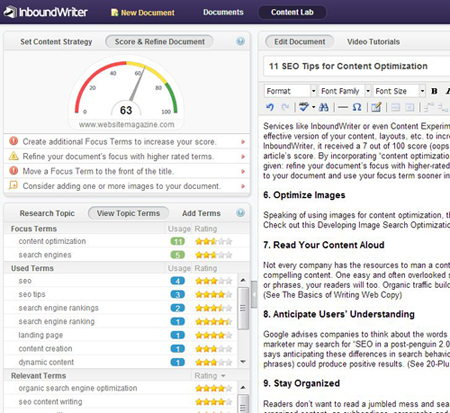11 SEO Tips for Content Optimization

Content - whether it be in-depth articles, short blogs, banner ad creatives, social posts or landing page copy - can always be better or, rather, optimized for both user experience and search engine rankings.
As more brands enter the information-publishing arena for the obvious benefits of improving search engine rankings and meeting consumer demand, they will need either to hire content curators or become writers themselves. Content optimization, however, can be time consuming for even the most experienced of authors, as it's easy to get side tracked in the research stage, get caught up in overly analyzing material in editing or get lost in imaging or formatting in publishing.
Instead of spending hours, if not days, tweaking content and not really knowing if it was better off in the beginning or the end, follow these 11 SEO tips for content optimization.
1. Make an Editorial Calendar
Depending on your industry, content can be scheduled out for a month or even a year in advance. By thinking ahead, businesses can ensure they plan their content and staff availability around holidays, company milestones, events (e.g. tradeshows, webinars), etc. This can help reduce the impact of seasonal lulls to avoid a dip in traffic and search-engine rankings. What's more, companies can look at the previous year's top and worst performing material to decide which content resonates best and what to emulate or toss in the new month or year. Editorial calendars can also include SEO-friendly material like tags, meta keywords and in-site and outbound links. Finally yet importantly, by planning editorial, teams can create a wish list of guest contributors or sources. By including high-profile executives or companies on your blog or in your white papers, you increase the likeliness of your material being shared by them, snowballing your content's visibility both on the search engines and with their audiences. Learn how to create an editorial calendar.
2. Get Personal
Publishing dynamic content tailored to an individual user's needs and wants is key to creating an optimized experience that increases the chances of them engaging with content (and improving your time-on-site, page views and other metrics search engines evaluate). L'Oreal Paris USA, for example, leveraged RichRelevance's RichContent to help each user find her signature beauty looks based upon stated characteristics, individual preferences and observed behavior. The result was delivering of a custom mix of content that is directly relevant to each individual consumer. This includes product recommendations, articles, videos, slideshows, special offers and more, that dynamically change in real time based on her goals and interests. (See: 20 Wonderful Web Personalization Tools For Merchants)
Aside from solutions like RichRelevance, there are also ways to personalize your email campaigns from almost any email service provider (ESP) by sending emails to different groups based on their past behavior. For instance, subscribers who have signed up in the last 10 days get one email (maybe introducing popular items) and subscribers who registered years ago but haven't engaged recently get a "We Want You Back" campaign. It may seem that emails don't have a direct influence on search engine ranking or content optimization goals, but with personalized campaigns, users are more likely to click through and drive traffic to your website, which does have a direct impact. Additionally, be sure that the landing page waiting on the other side of the email is relevant and meets users' expectations, so that your site doesn't suffer from high bounce rates. (See: Top 10 Split Tests for Merchants to Try)
3. Manage Expectations
Whether it's an online ad, an email or an article title, users expect to find relevant information once they click through, which is an important part of content optimization. For the latter, it's OK to be clever with title building, but optimized content matches and expands on the headline (and any keywords included in it). By providing the content that users expect, they're more likely to engage with your optimized content.
4. Include an Action (or Two)
Where should your readers go after they've consumed your content? Giving them options, either with a feed of similar or popular articles or sharing functions, increases page views and engagement, which the search engines respond to positively.
 5. Get Help
5. Get Help
Services like InboundWriter or even Content Experiments with Google can fuel your content optimization goals to determine the most effective version of your content, layouts, etc. to increase search engine rankings. By copy and pasting the first half of this article into InboundWriter, it received a 7 out of 100 score (oops).
The tips InboundWriter provided was to create a "Focus Term" in order to increase this article's score. By incorporating "content optimization" five more times, the score went from 7 to 51. On the latter score, additional tips were given: refine your document's focus with higher-rated terms, move a focus term to the front of the title, consider adding one or more images to your document and use your focus term sooner in the document. By incorporating a few tips, this article's final score was 63 or 71 with the image on the right.
6. Optimize Images
Speaking of using images for content optimization, there are rules to follow - from file names and Alt text to page placement and links. Check out this Developing Image Search Optimization article.
7. Read Your Content Aloud
Not every company has the resources to man a content creation team, so learning a few tricks of the trade can help non-writers craft compelling content. One easy and often overlooked self-editing practice is to read your content aloud. If you are stumbling over certain words or phrases, your readers will too. Organic traffic builds a site's reputation, and like Google says, that rarely comes without quality content. (See The Basics of Writing Web Copy)
8. Anticipate Users' Understanding
Google advises companies to think about the words that a user might search for to find your content. For example, a long-time Web marketer may search for "SEO in a post-penguin 2.0 world", whereas an SEO newbie may search for, "ranking first page of Google." Google says anticipating these differences in search behavior and accounting for them while writing your content (using a good mix of keyword phrases) could produce positive results. (Discover 20-Plus Free Keyword Tools to Know)
9. Stay Organized
Readers don't want to read a jumbled mess and search engines can't easily understand unorganized pages. Web users, particularly, like organized content, as subheadings, paragraphs and other layout separations make articles and other content easier to scan and consume.
10. Use Better Anchor Text
Hyperlinks with the "right" anchor text can play a significant role in improving SEO and content optimization efforts. Many Web workers, however, don't use anchor text appropriately. Check out SEO Mechanics - Anchor Text for a step-by-step guide to mastering this vital technique.
11. Users, Not Search Engines
Perhaps the most important content optimization tip is to create content for users, not Google, Bing or Yahoo. Keywords should relevant and appropriately placed.
Bonus: Be Mobile Friendly (Duh)
Read about the Barriers to Mobile SEO.
What content optimization strategies do you use or tell clients about? Fire off in the comments section below.









